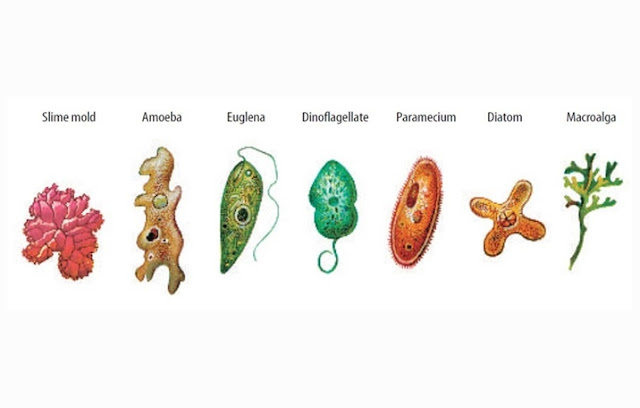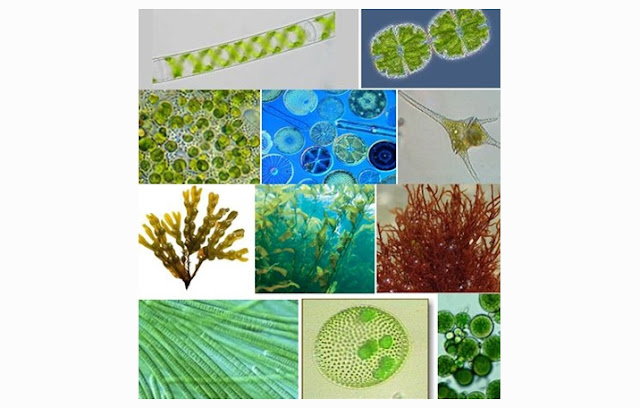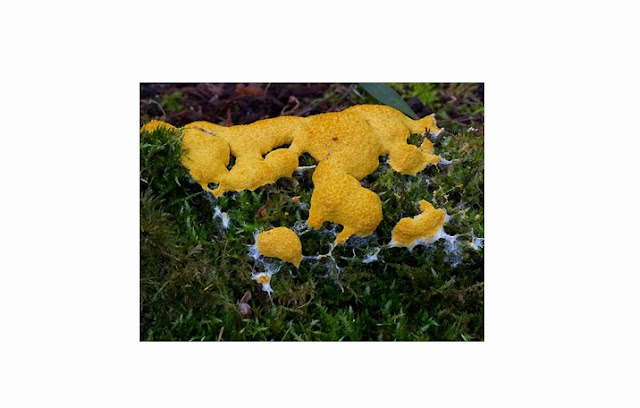A. UNDERSTANDING THE DEFINITION OF
PROTISTS
Protists is a living group of eukaryotic (cell wall)
that not included into the animalia (animals), Plantae (plants) and fungi
(mushroom) kingdom. Most members of the protist organisms are unicellular (only
one cell) but they also have members that are multicellular organisms (has many
cells). "Protist" comes from the Greek word, "Protos" which
means first and "zoa" means animals, it means, protists is a living
group of first eucaryote (simplest).
The classification system that puts the protists as a
separate kingdom is a system 3, 4, 5, and 6 classification system. While in the
7 kingdom classification system of living things, protists were not included
anymore. To understand more about the classification of living things please
visit our posts following:
 |
| PROTISTS KINGDOM |
B. STRUCTURE AND CHARACTERISTICS OF
PROTISTS
As we discussed above, most protists are unicellular
organisms.
- Most protists have additional organs such as flagella and cilia, which is a kind of fur that serves to move.
- These groups can be easily found in watery habitats.
- Protists can be autotrof (able to produce their own food) or heterotroph (unable to produce their own food).
- Based on the respiratory system, protist kingdom can be divided into two groups, which are aerobic (requiring oxygen) and anaerobic (living environment there is no oxygen).
C. CLASSIFICATION AND CHARACTERISTICS OF
PROTISTS
1. Animal-Like
Protists (protozoa)
As the name implies, Protozoa are unicellular
eukaryotic living beings who are able to multiply and move (like animals).
Protozoa are cosmopolitan organisms which means it can live and are found in
many places such as air, water, soil, etc. Protozoa can reproduce asexually and
sexually.
Sexually, done by conjugation with the attachment of
two organisms and core exchange.
Asexually, done by dividing.
Based on their tool of motion, animal-like protist divided
into :
1.
Zoomastigophora (ZooFlagellates)
Zomastigophora a group of Animal-Like Protist that
has flagella (whip feathers) as they tool of motion. Flagella comes from the
Latin meaning whip. Mastigophora derived from the Greek "mastig” which
means whip, and" phora " which meas movement. This group generally has
two flagella in his body, could both be in the back of the body, or (not infrequently) found in the front and
back of the body.
2. Ciliophora
(ciliate)
Ciliate is a group of Animal Like Protist that has
cilia (hairs vibrate) as they tool of motion. Generally, a unicellular
organisms that live solitary (alone) in freshwater habitats. In addition to
functioning as their tool of motion, cilia contained in all parts of his body.
Cilia function is moving the food to be able to enter through the mouth.
Because they can not produce their own food, then Ciliate including
heterotrophic organisms. Ciliate usually has two core cells called makronukleus
(larger) and micronucleus (smaller size).
3. Rhizopoda
(Sarcodina)
Rhizopoda is a group of Animal Like Protist that has
pseudo feet (pseudopodia) as their tool of motion. Artificial leg is derived
from cytoplasm of their cells. Spesies of Rhizopoda ie amoeba sp. often found
in ponds or water. Rhizopoda have a complex internal structure that allows it
to sense and capture prey. Besides functioning to move, artificial legs also
serves to capture their food. After the food is digested, the remaining results
of digestive substances will condense and pull out to the ends and then exit
their body. Because they can not produce its own food, then Rhizopoda is
heterotrophic organisms. Rhizopoda reproduce by splitting in direct (binary
fission).
4. Apicomplexa
(Sporozoa)
Sporozoa (Sporo = seed, zoa = animal) is a
unicellular organism that does not have the tool of motions. This organism
moves by contractions throughout the cell. Sporozoa live as parasites, and the
food is absorbed directly from its host. Many of its members have a complex
life cycle, therefore it is also called Apicomplexa.
5. Actinopoda
(Heliozoa and Radiozoa)
Actinopeda is an animal-like protist that has tapered
pseudo-foot (pseudopodia) emanating from his body as their tool of motion. This
type of Pseudopodia is called axopodia. Axopodia serves to make it float and
preying on other smaller organisms. Aticnopoda name means radiating leg or foot
beam. Most Actinopoda is plankton
6.
Foraminifera
Foraminifera are Animal Like Protists found in the
sea, sand, stick to rocks or algae. Foraminifera name comes from the word
meaning foramen hole. This group has a shell or skeleton composed by Calcium
Bicarbonate (CaCO3).
2. Plant-Like
protists (algae)
Unicellular Plant-Like protists often called
phytoplankton, while multicellular Plant-Like protists often called algae. Just
like its name, Plant-Like protists, algae or phytoplankton both able to perform
photosynthesis. Phytoplankton have an important role in providing oxygen to the
atmosphere through photosynthesis. Plant-Like protists is divided into seven
phyla :
 |
| PLANT LIKE PROTISTS |
1.
Euglenophyta
Euglenophyta is a group of Plant-Like Protists that
has such a dominant chlorophyll a, b, carotene, and sometimes xantofil pigment.
The number of species in the phylum is estimated at more than 800 species.
Euglenophyta Phylum is a unicellular organism that has flagella (whip
feathers), Spot on the eye that can capture light (called the stigma), and
chloroplasts. Name of this phylum are based on one of its genus called Euglena.
2.
Chrysophytes (Golden Algae)
Chrysophytes is a plant-line protists group that are
often referred to as the "golden algae". Golden-brown color on
Chrysophytes formed because it has such a dominant carotene and fikosatin
pigment, besides Chrysophytes also have chlorophyll. Number of species
Chrysophytes are about 850 species. Most of the species are photoautotrophs
organisms that can produce their own food through photosynthesis. Members of
golden algae have various shapes and sizes, there are also multicellular and
unicellular Chrysophytes.
3.
Baccilariophytes (Diatoms)
These phylum have the most species than other groups
of Plantlike protists. Total Species that have been identified about 10,000.
Generally Bacillariophytes is a unicellular organism that does not stir and
live as plankton. Pigments constituent of their bodies are; chlorophyll a, c,
xantofil, and the carotene. Their Cell Membrane contains pectin and silicate,
diatom can also secrete frustule (silium dioxide) so that when these organisms
die, then the shell will form diatomaceous earth that has a hefty selling price
because it can be used for various things.
4. Pyrrophyta
/ Dinoflagellata (fire algae)
Pyrrophyta / Dinoflagellata a plant like protists
that have the dominant form of the chlorophyll a and c, santofil, dinosatin and
fikobilin pigment. Constituent of the body covered with red pigment that can
capture light. Fire Algae is a group that can produce light (bioluminesens)
which is clearly visible at night. At a certain point, the population will
increase rapidly in the ocean, so at this time a large groupe of pyrrophyta
looks like a blazing fire in the ocean, thats why the name for this group is
Pyrophyta or fire algae. blazing fire events in the ocean is known as red tide.
When it appeared, the water have oxygen-poor conditions, also sometimes become
toxic so that when this phenomenon occurs many other living creatures are dead.
5. Chlorophyta
(green algae)
As the name implies, Chlorophyta had a
greenish-colored body. The dominant constituent of their body is chlorophyll
pigment, in addition they also have a little carotene (yellow pigment). In the
body of the green algae chlorophyll gather in a place called chloroplasts. Each
individual have different shapes of chloroplast, there is a round, spiral
shapes, such as stars, etc.
6. Phaeophyta
(brown algae)
Phaeophyta a plant like protists that have a dominant
xantofil pigment so that their body is brown. The number of species is about
1500 species, habitat mostly in the sea. Name of these algae in accordance with
their characteristics, "Phaeophyta" comes from "phaeios" a
Greek word meaning brown.
7. Rhobdophyta
(Red Algae)
Rhobdophyta a plant like protists group that have the
dominant form of fikoeritrin pigment so the color of the body is red. In
addition they also have phycocyanin and chlorophyll pigments.. Red algae body
composed of many layers cell, and they do not have flagella.
3. Fungi-Like Protists
Fungi-Like Protists are said similar to fungus
because it has the characteristics, structure, and method of reproduction like fungus.
The difference between them is : Fungi (Mushroom) has a zygote that can not
move (immotile) while Fungi-Like Protists have a zygote that can be move
(motile). Here are 3 groups of protists like mushrooms:
1. Myxomycota
(Slime Mold Plasmodium)
Myxomycota also known as Slime Mold Plasmodium. All
members are heterotrophic because they can not perform photosynthesis and is
unable to produce its own food. Slime Mold Plasmodium usually have a bright
color pigments, can be yellow or orange. In its life cycle, there is a phase in
which Myxomycota produce amoeboid cells (cells that can live freely) called
Plasmodium. Well, this plasmodium can grow to size reaches centimeters (cm),
however, this group mostly remains as a unicellular organism, they have large
size because of their cell membrane structure and their many nucleus.
2. Acrasidae
(Acrasiomycota)
Acrasidae a cellular Slime Mold, unlike the
Myxomycota which is a plasmodium slime mold. The basic difference between them
is acrasidae a haploid organisms (only one set of chromosomes), only their
zygote are diploid (two sets of chromosomes). While most of Myxomycota lived
his life as a diploid organism. acrasidae or cellular slime mold has a body
whose function is to produce spores when asexual reproduction occurs. Acrasidae
do not have a flagella. Acrasidae species that have been identified is about 60
species.
3. Oomycota
(Water Mushroom)
Actually the name of the water mushroom is not fit to
Oomycota, because not all of them lice in aquatic habitats.
"Oomycota" comes from "Oo" meaning egg and "Mycota"
means mushroom. Most oomycota life as decomposer and plays an important role in
aquatic habitats. Some members also live as parasites. Oomycota reproduction
can occur asexually and sexually. In Asexual they will form zoospores that will
be a new organism when it fall to the right place. While sexually with mating
of male gametes and female gametes.




